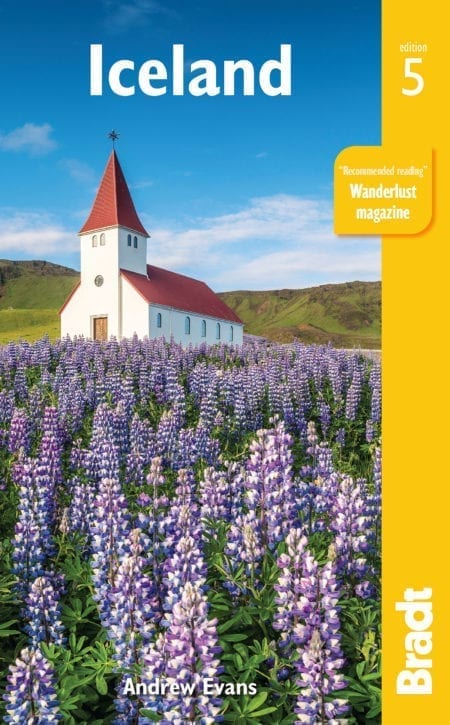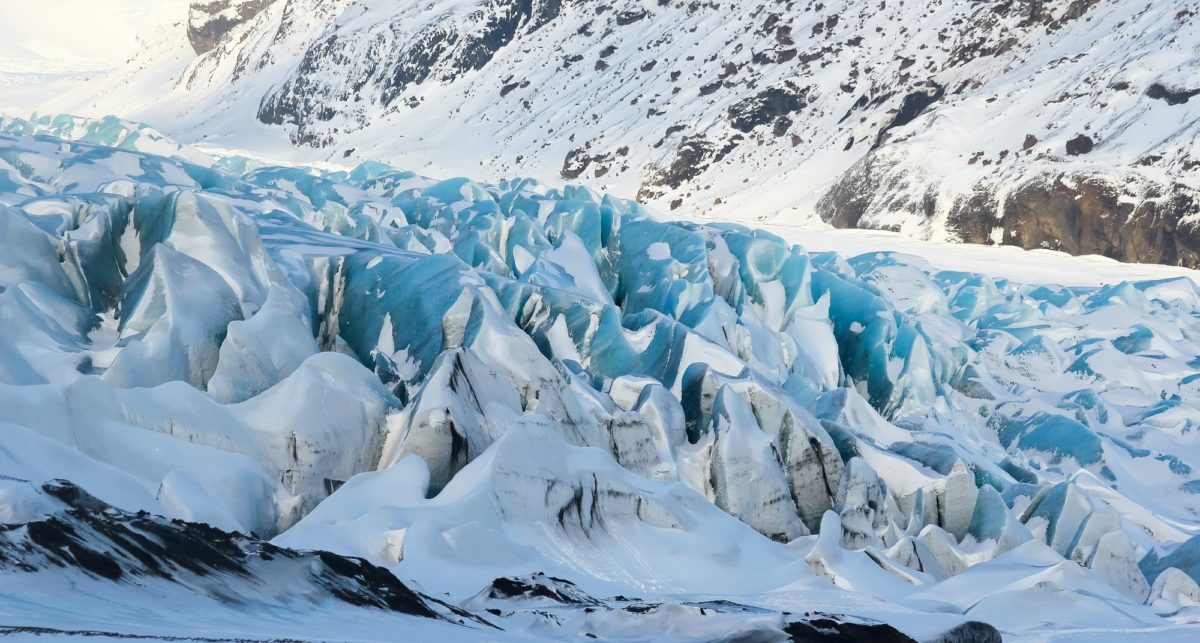Travelling to Iceland is much less about sightseeing than it is feeling things you’ve never felt before – what it’s like to be the only person on earth or how it feels to be outnumbered by a million-odd puffins.
Andrew Evans, author of Iceland: The Bradt Guide
Iceland is one of our hot destinations for the year ahead – check out the full list of the best places to travel in 2024 here.
The best part about writing a guidebook to Iceland is returning, over and over, forever learning new things and falling in love all over again. After so many years of continuous travel to Iceland, I am still amazed by this marvellous country – its incredibly raw nature, its mysterious ancient culture and the overwhelming beauty in every landscape.
Travelling to Iceland is much less about sightseeing than it is feeling things you’ve never felt before – what it’s like to be the only person on earth or the startling emotion of being outnumbered by a million puffins. Iceland’s gargantuan nature stirs the soul or it can shake you in your boots. That plume of mist on the horizon could be steam from a hot spring, the salty breath of a spouting whale, the early wisps of a week-long fog, or the conquering cloud of a massive volcano.
Today, literally millions of tourists are coming to Iceland each year, eager to experience that same strange sense of wonder. They come for the rumbling waterfalls, to soak in heavenly hot springs and to witness the last great glaciers of Europe. They discover the strange shapes of the bright-green mountains, the colours of the daunting sky and the shimmering fjords, and the joy of sunbeams after a hard-hitting rain. This is a land where horses grow long hair on their backs and where the liquorice aisle is the longest one in the shops. It is a place where everyone calls each other by their first name, where all the churches have tiny gold stars painted on their ceilings, and where postal addresses haven’t changed in 1,000 years. What’s not to love?
The need to protect nature from the onslaught of nature lovers has never been greater. The numbers of visitors who now come to Iceland is truly unprecedented. Most come with righteous intentions and tread lightly, but the poor choices of a few can have long-lasting effects. As a unique destination in our world, Iceland deserves the upmost respect, both culturally and environmentally. My guide to the country is dedicated to responsible, low-impact travel that benefits Iceland wherever possible.
I hope that you enjoy Iceland as much as I do – may yours be a wonderful trip and may the sun and northern lights shine brightly for you.
See also this article on travelling through Iceland in the summer and this guide to travelling to Iceland with kids.
For more information, check out our guide to Iceland:
Food and drink in Iceland
Food
Icelandic cuisine relies on anything that could be harvested from the barren landscape. It is simple in that its ingredients are what can be pulled from the ocean or what can live off the earth. That means fish, sheep, and the few things that do grow in Iceland – potatoes, blueberries, rhubarb, and caraway seeds. Once upon a time, Icelanders ate a greenish porridge made from boiled moss. Lifestyles have since improved, but there is still a blend of what nature provides and whatever can be shipped from Scandinavia.
Learn your Icelandic fish and you’ll know something about what’s on your plate. Cod (thorsku) is a mainstay and on every menu. Traditional throughout Scandinavia is fiskbollur – fried balls of fish and herbs – though the quintessential Icelandic dish is plokkfiskur: flaked white fish (typically plaice) cooked in white sauce with onions and mashed potatoes. Icelandic salmon (lax) is some of the best in the world.
With so many sheep around, lamb is the red meat option most preferred by Icelanders. They use their cows for dairy, so beef is not traditional (though steak is now listed on every menu). The same goes for horse meat, which was once taboo, but is now a common tourist dish. Whale is unfortunately not taboo, and is still more common than people think. Both the meat and the blubber are eaten, often heavily salted or pickled.
Vegetables and fruit were never Iceland’s forte, but potatoes did catch on in the 19th century. Icelanders avoided getting scurvy by eating scurvy grass and blueberries. Bláber are actually bilberries and they grow so ubiquitously that you can get filled up just by picking them as you walk. The berries are sweet, juicy, and tart (and blue) and are best from August and into September.
Compared with the rest of Europe, Icelanders devour an alarming amount of dairy products. Icelandic butter, milk, yoghurt and ice cream are some of the best you’ll ever taste, and the truly unique skyr is downright addictive. Traditional Icelandic cheese is little known outside the country, but ranges from very soft brie-like cheese to harder Edam-style cheeses.
Drink
The first thing that anyone should drink in Iceland is the water, which is incredibly pure and tastes so good that upon returning home, you’ll feel disappointed by your tap. In most places, it is quite safe to simply dip into the clear rocky streams, waterfalls, and lakes and drink the cool water. Almost all the cold water you encounter is glacial run-off and free from the sulphur smell that comes with naturally heated groundwater. When searching for a spot to drink from, look for clear water flowing over rocks. If you are somewhere remote and there’s nothing animal or human upriver, the water is safe. Otherwise, use caution if drinking water near farms, cities and dams. Mineral springs dot the countryside, some of which are naturally carbonated and bottled Icelandic water is sold everywhere.
The Icelandic national religion that is coffee has been in force ever since the Danes first brought it here. No matter where you go, you will be offered a cup of coffee, typically with lots of sugar and lots of milk. Even when people speak of ‘tea’ they usually mean coffee. Finding a good cup of tea in Iceland isn’t that easy.
Health and safety in Iceland
Health
Happily, you do not need any immunisations to travel in Iceland (although it is advisable to be up to date with all UK recommended vaccines, including MMR and DTP). Even better, because of the climate, there are very few bacteria in the air. Also, the water in Iceland is some of the cleanest in the world. Drink as much as you like, but only out of clean sources. The higher up you are, the safer it is.
Mountain waterfalls, glaciers, streams and cold springs are optimal. Otherwise, health concerns for travellers in Iceland are minimal. When hiking, avoid blisters by wearing boots that fit and bring plasters to cushion sore spots. Also use caution on rough paths and in dangerous places (like high cliffs). Bring lip balm for wind-burn and lotion for dry hands. Avoid mass-produced seafood at all-you-can-eat tourist buffets, and in misty mountainous areas, beware of large trolls.
Safety
Iceland is the safest country on earth – it is highly unlikely that you will get pickpocketed, kidnapped, caught up in a coup, attacked or contract malaria. However, Iceland is also one of the most dangerous places on earth, with a possible threat of volcanic eruption, earthquakes, avalanche, glacier outbursts, tidal waves, blizzards, and other treacherous weather conditions. Expect nothing, but be prepared for anything.
The number-one concern for foreign travellers is road safety. All too often, foreigners assume (wrongly) that driving in Iceland is the same as anywhere else. Drive very carefully and take extra precautions. Never speed, and always remain alert, obey signs and carry plenty of fuel.
Weather is another root cause of concern for safety in Iceland. Icelandic weather is unpredictable and can be highly problematic. Icelanders cope by going with the flow and never testing the limits. The first rule is to check the weather and the second is never to take the wind for granted. Hurricane-force gusts are serious business that can blow cars off the road and make travel impossible. Add a random bout of rain, sleet or snow and it’s not a pretty picture. If anyone warns you not to go out, then don’t.
The same thing that makes Iceland beautiful (isolated, uninhabited landscapes) can also be hazardous. The ‘middle of nowhere’ is a good description of much of Iceland – one step off the main road is a step away from civilisation and carries the same potential risks as a hike across the Sahara Desert or a trek in the Himalayas.
Iceland’s universal emergency number is 112, emergency huts are available in remote areas, and the Icelandic Search and Rescue can be a vital resource. Still, common sense and emergency preparedness always make for the safest travel.
Crime
Crime in Iceland is so petty, it’s almost pitiful. Cases of vandalism and public intoxication outnumber theft. The rare violent crime that does take place almost always involves late-night drinking and carousing. Avoid drunk people.
Because Iceland is packed full of tourists in summer, thieves may target unassuming foreigners who have let down their guard in a perceivably ‘safe’ situation. If you are a victim of a crime, dial 112 and report it to the police or Lögreglan. They are always helpful and most speak excellent English.
Female travellers
Iceland is a very progressive country that is light years ahead of most when it comes to women’s rights. Icelanders will be the first to remind you how they elected the first woman president in the world and insist that Icelandic women face little discrimination in their society. As concerns safety in Iceland for women travellers, this is a place to wander freely and experience nature fully without apprehension or taking special precautions.
Even so, the savvy woman traveller should always travel with a good set of ‘street smarts’. Potential threats (injury, theft, intimidation) are just as likely (if not more so) to come from fellow foreign travellers. Take special care in campsites and remote mountain huts where potential lack of protection and sheer isolation might place you in a vulnerable position.
Most hostels or guesthouses with sleeping-bag spaces will offer women-only rooms. Likewise, women should not hitchhike on their own. Potential confusion might also arise within Iceland’s particular club culture, where women often play a dominant role that may lead some men to expect more than you are willing to give. Bar-hopping in the middle of the night (even when it’s light outside) poses the exact same risks. There is safety in numbers, while pairing off with strangers is always a huge risk.
Racial minorities
Not all Icelanders are blonde with blue eyes, but a good many of them are really, really white. For that reason, a variation in skin tone is enough to make you stand out in certain parts of the country. In general, Icelanders are open minded, well educated, hospitable, thoughtful and discard the notion of prejudice.
Like most Scandinavians, Icelanders are all about cosmopolitanism and equality, which means that racism gets expressed in more subtle tones. Nobody will shout ethnic slurs at you, but you may get the sense that some people are just a little bit unnerved by your presence. That’s not so much the case in Reykjavík, which is now very much a global city, but the remote hinterland may respond differently.
A new wave of African and Middle Eastern refugees, Thai and Filipino workers, and other non-European residents has established a foothold in the country, so a tiny twinge of anti-immigrant fervour just might get projected your way. The issue is less about race per se and more about the potential for a less-Icelandic Iceland. You might get stared at a lot, and some kids might even run up to rub your skin, but most people will treat you fairly. To break any tension, say something in Icelandic.
Travellers with disabilities
Travellers with a disability will find Iceland to be a place that cares about giving all people the right to experience the country fully. There is a very real and sincere push to make the entire travel industry wheelchair-friendly, and in principle, Icelandic law grants disabled travellers equalopportunity access to most public activities (swimming pools, museums, etc).
This includes the latest technology to assist those with visual and hearing impairments. For more information on services available to deaf travellers, contact the Icelandic Association of the Deaf. Icelandic sign language is interesting in that it derives from Danish and is therefore quite different from spoken Icelandic – interpretation services are available at the association.
Similarly, the Icelandic Association of the Blind can help arrange for an appropriate guide for visually impaired travellers. While a majority of hotels and farms claim to offer wheelchairaccessible rooms, I have made special note in the reviewed accommodation of those that actually do.
These include hotels with at least one ground-floor unit, ramps, and equipped bathrooms. A great online resource is the Icelandic equal rights organisation Sjálfsbjörg, which provides updated coverage on travel topics for less-mobile people and also offers accessible rooms in Reykjavík.
LGBTQ+ travellers
By law, all lesbian, gay, bisexual and transgendered persons are equal and protected from discrimination in Iceland. Since 2010, same-sex couples have been allowed to marry, but LGBT Icelanders have enjoyed full legal protection for decades. In fact, Iceland is the first country ever to have an out gay prime minister.
While Icelanders are very accepting of LGBT persons as a minority group, the numbers of LGBT individuals in Iceland are so few (per capita) that there is no prominent gay subculture. For example, Reykjavík’s gay pride festivities attract a predominantly heterosexual crowd that just like a good party. The Reykjavík mayor is known to take part in the gay pride parade and typically dresses in drag, along with his wife, and in 2016 Iceland’s president was the first head of state ever to march in a gay pride parade
The political issue is such a non-issue that there is no need to sequester anyone for the sake of solidarity. Similarly, there is no gay ‘scene’ in Iceland. Reykjavík boasts a single official gay bar, Kiki Bar, and a few other noted clubs – though their status of ‘gayness’ is in constant flux.
The best resource for tapping into Iceland’s gay community is the gay rights organisation Samtökin 78, which hosts a weekly gathering in its upstairs lounge/library. In general, LGBT travellers should face no ill will or difficulty. Booking a room as a same-sex couple is hardly an issue, and there is no need to hide the fact that you are a couple. Iceland being Scandinavia, public displays of affection are frowned upon, regardless of gender and orientation.
Travelling with children
Children rule supreme in this Scandinavian welfare state, which leaves you little reason to leave the kids back home. Despite Iceland’s high prices, nearly every service (transport, museums, shows, tours, accommodation, etc) offers at least a 50% discount to children under the age of 16 and, more often than not, young kids get in free.
The potential cost should be secondary to the experience that awaits. Iceland offers amazing adventures and incredible learning opportunities – it is very hard to be bored.
Travel and visas in Iceland
Visas
All travellers must have a valid passport that expires three months after the intended date of departure with at least two blank pages for entry and exit stamps. Visitors from the UK, Ireland, the USA, Canada, Australia and New Zealand who are travelling on holiday or business for 90 days or less do not require a visa. For longer periods, you must apply for a visa with the Icelandic Directorate of Immigration. Visas are issued to individuals as tourists, for family visits, official business, commercial business and as students.
Iceland is part of the Schengen Agreement, which means visitors from Schengen countries do not require a passport, and those visitors requiring a visa must apply for a Schengen visa. In countries without an Icelandic embassy or consulate, visa applications are typically accepted at the embassies of Denmark or Norway. For the latest information and for any questions, check out the website for Iceland’s Ministry of Foreign Affairs.
Getting there and away
By air
Flying to Iceland is the simplest and cheapest part of the journey. Few travellers realise that Icelandair is the longest-running transatlantic airline still in operation today (since 1937). With Keflavík as its hub, Icelandair services 33 destinations in North America and Europe. From Europe, the flight is about 2–3 hours; from the east coast of North America the flight lasts 4–5 hours.
British Airways flies direct from London Gatwick to Keflavík, and SAS flies direct from Oslo to Keflavík. Travellers can also fly to Iceland from the Faroe Islands or Greenland. Air Iceland offers a regular service to Tórshavn in the Faroe Islands, and to Kulusuk, Narsarsuaq, and Nuuk in Greenland.
By sea
Nothing compares to catching your first glimpse of Iceland from the sea. The first Viking to spot Iceland sailed in to the East Fjords, and today the tradition continues. Smyril Line is the Faroese shipping company that operates the ferry Norröna with a service to Iceland. Most travellers go by boat in order to bring their own caravan, car, 4×4, motorcycle or bicycle. Taking your own vehicle to Iceland can save you a pile of money. Paying for passage and cabin space on a ferry, even with the option of an extra stay in the Faroe Islands, is still cheaper than renting something in Iceland. The Norröna crosses the North Sea between the ports of Hirtshals (Denmark), Tórshavn (Faroe Islands), and Seyðisfjörður (Iceland).
Getting around
By air
Flying is the very best way to see Iceland’s marvellous landscapes. With so few roads and such massive wilderness, a flight can show you what you cannot see on your own (so always request a window seat). Air Iceland is the country’s main airline, with regular flights between Reykjavík and Ísafjörður, Egilsstaðir, the Westmann Islands, and Akureyri, and from Akureyri to Grímsey, Egilsstaðir, Thórshöfn, and Vopnafjörður. Air Iceland also operates a number of ‘action-packed day tours’ from Reykjavík. These are short, intense excursions that normally entail a 1–2-hour flight to a distant corner of Iceland and a day of activities such as kayaking, birdand whale-watching, or touring natural reserves. If your time is limited, these are a great experience.
By car
Driving in Iceland offers total freedom and is one of the most extensive means of travel in the country. Iceland has a car culture, so travellers who aren’t driving often feel stranded or limited. So much of what there is to see and do in Iceland is only accessible on wheels, and without a car, travellers must resort to ‘public transport’ and overpriced tour operators.
Car hire
In Reykjavík, a trusted supply of cars meets a significant demand for renting them. Local companies sometimes offer better deals, while international companies may offer several different offices, allowing a pickup or drop-off in another location (eg: facilitating travel between Reykjavík and the airport in Keflavík). Any companies located outside the city centre will also usually offer free pickups/drop-offs at your hotel. It pays to shop around, as special offers are a way of life.
Cozy campers offer a range of budget campers at affordable prices.
By bus
In principle, an extensive bus network covers the whole of Iceland. BSÍ is the national bus station in Reykjavík and the starting point for most journeys. There is no national bus line per se, but rather a loose configuration of private bus companies that appear to align their schedules (not unlike the British rail system). That means coordinating long-distance trips and complex, multi-day itineraries can be a small headache. To make it easier, travellers are offered a series of convenient bus ‘passports’ that allow for unlimited transport over a specific period of time (one to four weeks) over a particular region or the whole country. You can also purchase discounted passes like the full circle passport, which allows unlimited summer travel (June–September) on the ring road as long as you keep moving in the same direction (no backtracking).
For the latest information on buses, check with the operator Reykjavík Excursions and the smaller companies such as SBA-Norðurleið and Trex.
By boat
One could argue that Icelanders fare better in boats than they do in cars. Quoting the Icelandic Coast Guard (‘half our homeland is the sea’), going by boat lets you see the other half of the country. Main ferries include the Westmann Islands, Grímsey, and Breiðafjörður, as well as the boat to Hornstrandir. Smaller boat tours (whale-watching, island excursions) are also widespread.
By horse
Icelanders have been exploring their country by horse for the last 1,100 years. The animal is such a part of the landscape that some would say that horseback is the only way to go. The fact is that horses can go where no-one else can. That’s why horseriding tours across the interior are ideal.
When to visit Iceland
You can visit Iceland at any time of year and have a wonderful time, but what kind of experience you have depends a lot on when you go. A trip to Iceland in July versus a trip to Iceland in December feels like two different countries. Summertime allows you the freedom to go almost anywhere in the country, to hike outdoors, to stay up all night, and to experience Iceland’s tourist industry in its prime. Best of all is summer, when all the animals (especially birds) are out in full force, as well as all the flowers. The landscapes glow bright green and Iceland feels like an undiscovered Eden.
Come winter, everything in Iceland turns white, diverting your eyes to the bright wooden houses and the subtle changes in the sky. The weather may or may not be treacherous, but where you go and what you can do is more limited. You can, however, ride horses in the snow, ski and snowmobile, see the Northern Lights at their best, soak in hot springs whilst thumbing your nose at the cold, and experience Iceland at its iciest.
For travellers, the main difficulty is the way in which Iceland has developed into a seasonal destination. Hotels, restaurants, museums, airlines and tour operators try to cram all their profits into a six-week summertime blitz. That’s why the summer is always booked solid and why everything costs twice as much. Don’t buy into that mindset and you’ll feel liberated. Rather, plan your trip based on what it is you want to do. If you want to hike glaciers, go early (April/May) or late (October) when the ice is firm and less prone to crevasses. If you want to see puffins en masse, then go in July; if you want to see their puffin chicks, then go in August. If you want to ride in the sheep round-up, go in mid-September. If you want to witness the Northern Lights, go in November; if you want to test the theory that limited daylight affects mood, then try late December, and if you want to conserve your cash, go in November or February. The wind blows all year round.
Calendar
January
Catch a glimpse of the northern lights
Many make the winter pilgrimage to Iceland to catch a glimpse of the aurora borealis. Created by solar storms, there’s nothing quite like watching the northern lights dance across the sky in all their green glory.
March
DesignMarch, Reykjavík
Iceland’s rich and unique design scene is celebrated in the annual DesignMarch festival, held at the Icelandic Museum of Design and Applied Art. Guests can check out everything from tanned fish-leather fashion accessories to inventive product design.
June
Iceland’s national day
Iceland’s national day (Þjóðhátiðargurinn) or independence holiday is on 17 June. Festivities normally include a big parade and picnics and a jubilant mood. People wear national dress and fly Icelandic flags – it’s a great time to visit because these are the longest days of the year.
International Viking Festival, Hafnarfjörður
Typically held in mid-June, the festival focuses around an outdoor market, swordfights, music, dancing, and your usual Renaissance fair fare but with a Viking twist.
July
Hike the Laugavegur Trail
Take advantage of July and what is likely the best weather of the year for Iceland. Locals get their summerhouse keys ready and head out chasing the midnight sun. Do the same and embark on the Laugavegur Trail (Laugavegurinn) that will take you from hot springs to snow fields, glaciers, mountains and lava fields over four breath-taking days of trekking.
August
Jazz Festival, Reykjavík
Reykjavík’s jazz scene goes way back to the very beginning and is known for its very eclectic expression and enthusiastic local following. More information about the annual festival can be found on its website.
Fiskidagur, Dalvík
In a heartfelt attempt to lure tourists up off the ring road, Dalvík hosts the annual Fiskidagur or ‘fish day’ festival in mid-August, which involves the townspeople stuffing you with copious amounts of seafood (for free). It’s a delicious distraction.
September
The roundup
The roundup (réttir) takes place in the early autumn, between 1 and 30 September. After a summer of free grazing up in the highlands, the sheep are rounded up and chased back down to their respective farms.
Icelanders show great skill on their horses, and it’s a time of outdoor activities like camping and horseriding – those who can experience this annual event in person, should.
October
Remember John Lennon at Yoko Ono’s Peace Memorial
Yoko Ono’s peace tower, an installation that projects a beam of light into the sky is lit on John Lennon’s birthday 9 October each year and turned off on 8 December, the day of his death.
Yoko set up the tower on Videy Island in memory of her husband and his message of peace. She has said she chose Iceland because the island is regularly voted the most peaceful country in the world.
November
Iceland Airwaves, Reykjavík
Iceland Airwaves is the mega-huge, much-talked-about music festival that rocks Reykjavík every October/November. The hype is well deserved and if you happen to be around, you’ll hear well-known international headliners play alongside Reykjavík’s many bands, both crazy and sane. Iceland Airwaves has been attracting huge headline groups in recent years.
Christmas village, Reykjavík
The Christmas village picks up at the end of November and is open every weekend until Christmas Day. It’s all about shopping and Santa Claus (and elves!), but with enough Icelandic flavour to make it credible.
December
New Year’s Eve
New Year’s Eve (Gamlárskvöld) is the party to end all parties: Icelanders light giant bonfires and then blow up all kinds of fireworks – even winter-dark Reykjavík lights up like a rocket.
Traditionally, New Year’s Eve has also been a time of magic, when humans could trick the hidden people into giving them gold.
What to see and do in Iceland
Akureyri
Akureyri may be the most civilised place in Iceland, insisting on normality despite its Arctic reputation. Nowhere else are gardens planted with such gusto: there’s a white picket fence around nearly every well-kept ‘gingerbread’ house, and sailboats glide up and down the fjord all day long. Church bells chime the hour, the streets are lined with tall trees and someone sweeps the town square with a broom. There are days when the town feels a bit like a child’s drawing. It’s precious.
Akureyri lies at the base of Eyjafjörður, surrounded on either side by a sloping wall of snow-capped mountains. The determined town clings to one hillside before spilling on to a small stretch of land that seems to float upon the shimmering water – hence the name Akur-eyri, or ‘the field upon the shoreline’.
The view is simply astounding, but the scenery also blocks out a good deal of bad weather, granting a unique play of sun and fog. Clear skies mean lots of sunny days (and nights) in summer and a healthy dose of clean snow come winter.
Akureyri often gets tagged with labels such as Iceland’s ‘second city’ or ‘capital of the north’, though the actual population (around 18,000) and size (the country’s fourth largest) imply otherwise. Why it gets the nod as the ‘other big city’ is because it’s the only town that gives Reykjavík a run for its money. It may be small and compact, but it’s also a very independent place.
It’s also a great place to visit, as a destination in and of itself, for the idyllic countryside of Eyjafjarðarsveit, or as a home base from which to suit up and explore great swathes of Iceland’s wildest landscapes. Beyond the well-trodden tourist path to ‘big’ attractions (Mývatn, Goðafoss and Húsavík), Akureyri allows easy access to some of the country’s less-visited parts (eg: Grímsey, the interior, and the outermost corners of Thingeyjarsýsla).
What to see and do
Orient yourself at the main intersection of Hafnarstræti and Kaupvangsstræti. Akureyri Cathedral is on top of the hill and the town spreads out from the Raðhústorg, the paved town square (that’s really a circle). Akureyrarkirkja is the work of Iceland’s one and only state architect Guðjón Samúelsson, and may be the best example of his departure from classic Art Deco in search of something unique and Icelandic. Even the diehard traditionalist can be intrigued by the repeated square forms in the striking façade, though perhaps the real beauty of Akureyri’s church is found inside. It’s a wonderful place to take a few minutes to sit and enjoy the serenity.
Innbær (inner town) is the thin strip of flat land that hugs the coast of the fjord towards the south. The fact that Aðalstræti (Main Street) is nowhere near the city centre says something about how Akureyri is the combination of several different settlements. At the bottom of the street is the standard Icelandic duck pond, where you can see plenty of ducks, oystercatchers and terns, as well as whatever else is stopping over while you’re there. In summertime, a good number of pink-footed geese add their own colour to the display. Right across sits the black-and-white Nonnahús, childhood home to Jón Sveinsson, identified by his kindly statue.
Next door is the Svalbarð church, built in 1846 on a farm in Eyjafjarðarsveit and transported to this spot in 1970 to replace the original Akureyri church (built in 1862). During World War II, the British Forces used the Akureyri church as a military post, after which it had to be torn down. The trail leading up the hill from Nonnahús and the church leads to the Akureyri Museum.
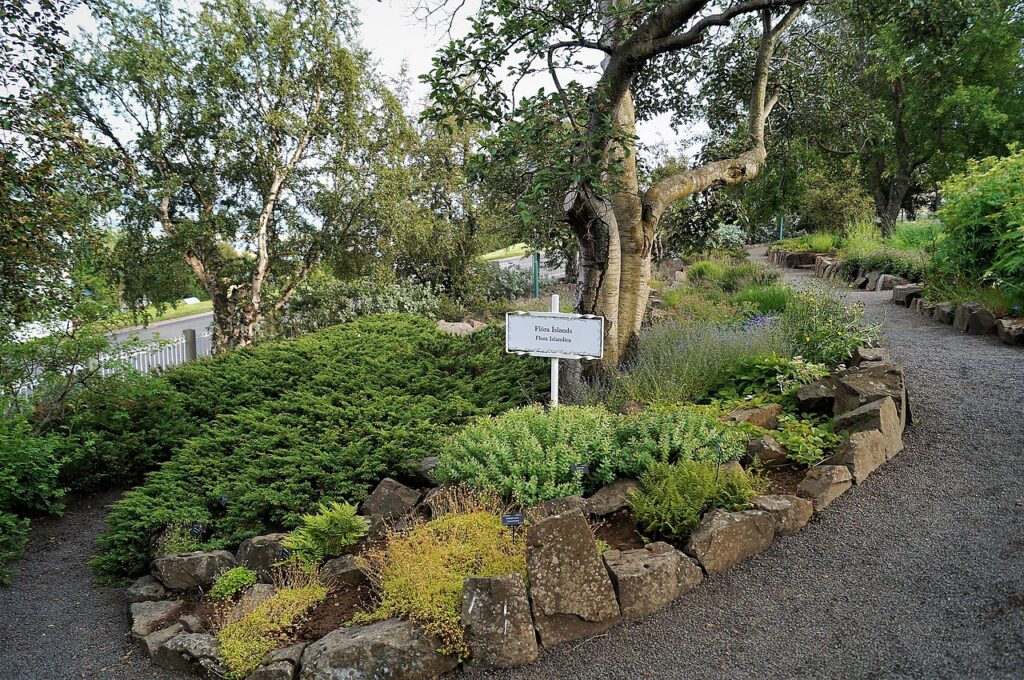
In 1912, an Akureyri women’s co-operative started the much larger Akureyri Botanical Garden. Today this bona fide botanical garden fills a very large city block. It’s a great place to get acquainted with Icelandic flora: they’ve got at least one of everything that grows in the country, although what you actually see depends on when you come.
East Fjords
Iceland’s east coast is a rugged fringe of long, V-shaped fjords in between rows of layered, pointy mountains. There are 14 fjords in total (not counting the smaller bays) and each one cut out by the fast-moving glaciers of the ice age. These eastern fjords are said to be the oldest in Iceland, evident in the jagged peaks that time has sharpened (younger fjords have flat-topped mountains). The most basic things make this area so extraordinary – the unnamed waterfalls, the single fishing village at the base of each fjord, and the way the sunlight hits the mountains from the east.
As an area, the East Fjords has always felt a little secluded from the rest of Iceland, which makes it one of the most serene and isolated places to visit. The narrow fjords are a more dependable outlet than the barren highlands, and the ring road had no choice but to careen its way around each of the channels.
For all those people whizzing past on Route 1, the East Fjords represents the part of the journey where most people wish they could stop and stay awhile, simply for the view. Every curve in the road is heightened by the surprise of the scene unveiled in the next fjord – it’s no coincidence that so many travellers’ tales begin with: ‘We were driving in the East Fjords, when …’.
Singular fishing villages cling to the base of each fjord – each is home to a few hundred people, and each is totally different from the next one over. After slowing down in the 1990s and 2000s, owing to a drop in fishing, tourism in the country has once again brought new life to these idyllic hamlets. Town museums (some are better than others) aim to lure unsuspecting tourists, but the main attractions are the fjords, the people and birds who live there, the incredible rocks on the ground, and the extraordinary hiking.
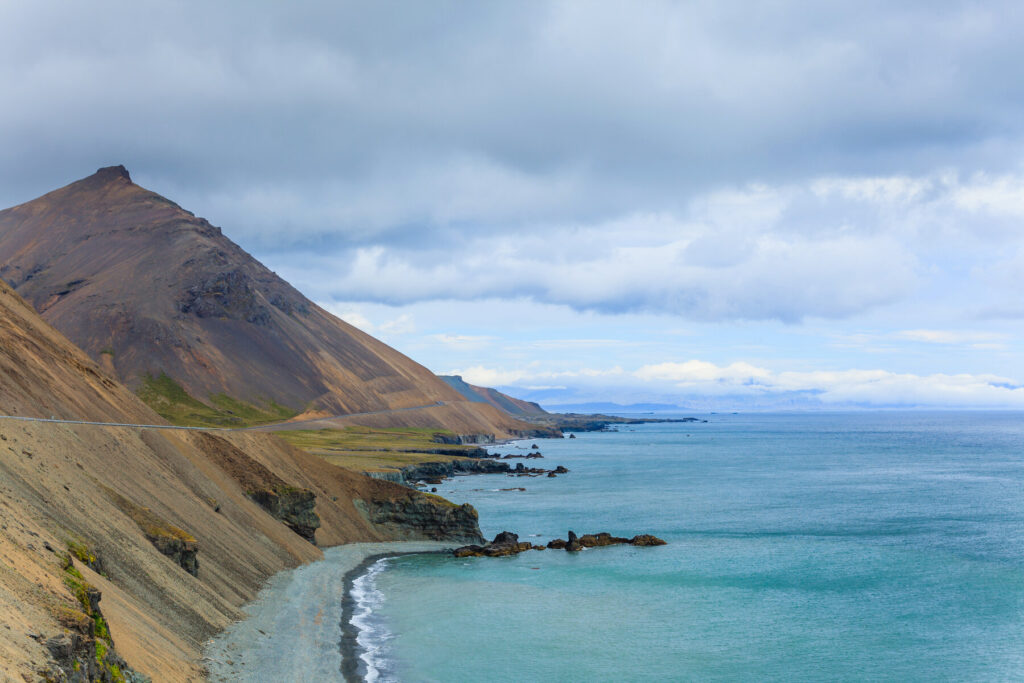
Borgarfjördur
The northernmost point of the East Fjords is terrifically beautiful and well out of the way of the tourist mob. If you like rocks and birds, this is heaven. Because there was already a much more famous ‘town fjord’ on the west side of the country, this one is known as Borgarfjörður eystri (the east). The best reason to head out to this abandoned little corner is to hike: the Dyfjöll Mountains are grand – the views feel almost alpine – and the trails are numerous and amazingly well kept.
The ultimate walking experience is in the Víknaslóðir, or ‘abandoned bays’. Take along the detailed map that’s sold at all the local businesses (as well as the information centres in Egilsstaðir and Seyðisfjörður), and note that most people venture into the region for several days. If you can, check out the lonely wooden churches at Húsavík and Klyppstaðir – truly the end of the earth. There are mountain huts and a campsite in the abandoned bays of Húsavík and Breiðavík.
Seydisfjördur
As the main ferry port to and from the continent, Seyðisfjörður plays back door to the whole of Iceland. Despite the crowds of travellers pouring in and out of the town, Seyðisfjörður remains a humble little place of 800 inhabitants at the end of a long (18km), narrow, and slightly S-shaped fjord. Seyðisfjörður is irresistibly cute and yet so unaffected – as first impressions go, this may be one of the most fitting that Iceland can offer to a visitor.
The town was founded by a Norwegian fishing company in 1895, and functioned as a major herring port until the herring disappeared some 50-odd years later. Like many Icelandic towns at the time, Seyðisfjörður materialised overnight as a completely prefabricated town, shipped in boxes from Norway and nailed together before the winter snows arrived. It is one reason why Seyðisfjörður is such a clean- cut town today. The way that all the houses, warehouses, and church match one another is almost toy-like, especially against the background of a giant, ocean-going vessel, and the handsome pair of mountains on either side.
Eskifjördur
Eskifjörður is another Norwegian herring town turned post- industrial Icelandic fishing village. What makes it a worthwhile stop is how curious and simple a place it is today – a single road (Strandgata) runs through the town, past the harbour with its fishing boats, the marine museum, and the quiet, undisturbed lives of about 1,000 people. Since nobody else seems to stop here, the few foreigners who do are treated to a candid glimpse of everyday life in isolated Iceland – the only thing that’s posing here is you.
Year-round, the bus company Strætó offers a daily service to and from Reykjavík (6hrs), Egilsstaðir (4hrs) and Húsavík (1hr 15mins). In summer, each line increases to two to three trips a day. They also operate buses to and from Siglufjörður (1hr 15mins) via Dalvík (45mins) and Ólafsfjörður (1hr) three times a day.
Grímsey Island
The tiny isle of Grímsey is an utterly pure and separate world from the rest of Iceland, 40km (24.5 miles) off the northern coast. As the country’s remotest (inhabited) offshore island, Grímsey grants the traveller the gift of isolation and windswept beauty. On one side, a mighty wall of basalt cliffs stands firm against the open sea – from these great heights the island descends in a slope of green lumpy fields to the opposite shore with its lowly coves and harbour. The island is pleasantly small (5.3km² or two square miles), like a punctuation mark for the whole of Iceland. Besides a handful of resolute islanders and a few million seabirds, there are only rocks, grass, the wind and the sea.
Just being on Grímsey feels like stepping off the edge of the earth. The next stop north is the North Pole and when the sky is clear, locals point south to ‘Iceland’: the jagged line of grey-ish mountains that stretch from Skagafjörður to Melrakkaslétta. Exposed as it is, Grímsey gets hit with the full force of Iceland’s terrific weather in the summer and less-than-terrific weather in the winter.
Things are always a bit blustery, the fog rolls in and out and then the wind picks up. There’s sudden rain, sleet, hail, or snow – huge waves crash on all sides and then, total silence. On those days, Grímsey feels like the most peaceful place on earth. On other days, watching the sky is sheer entertainment. Grímsey is also one of the few spots in Iceland where you can see the entire ‘midnight sun’ above the horizon, and in winter’s months of darkness the northern lights streak a bright blue, green and red.
What to see and do
The southern end of the island descends in a chain of broken rocks and skerries, and it’s a good place to (safely) watch the furious sea. The fluorescent-orange Grímsey lighthouse sits square and squat at the edge of the southernmost cliff, built in 1937 and still functioning in winter. On a clear day, the view of the mainland from the lighthouse deck is magnificent. Moving up the road takes you past several old farms up to Grímseyarkirkja. The island church was built in 1867 out of driftwood, replacing a turf church dating from 1254. The white- and-red exterior is classic for Iceland, as is the cerulean roof and gold stars indoors.
Most of the ‘town’ is in the middle of the island next to the harbour. Vallargata is the residential street that looks incredibly suburban; Hafnargata is the street by the harbour. There’s always something going on by the water, and it can be interesting to watch the fishermen unloading their catch, typically in the afternoon. The large building on the hill above the harbour is the island’s salt cod factory where the fish is cleaned, salted, and packed for shipment. Someone’s always working here, but you can normally take a peek or else arrange for an informal tour (it smells awful).
Past the town and up the road are the airport and the Arctic Circle Monument, complete with the photogenic ‘Grímsey’ sign. However, since its inauguration in 2017, travellers looking to actually cross into the Arctic Circle must make the trek to the permanent artwork Orbis et Globus. This giant concrete sphere at the far northern tip of the island tracks the shifting boundary of the Arctic Circle, which changes annually with the tilting of earth’s axis. Each year, before the summer solstice festival, the sphere is rolled to its new location. However the boundary is notoriously difficult to nail down.
Hornstrandir
The purest part of Strandir is the ‘horn’ – the final peninsula that juts over the top of the West Fjords. It is a daunting place for its intense beauty and extreme nature. The mountains are pyramid-shaped, sharpened by constant ice and wind. The cliffs stand up like defiant walls against the sea, and the intermittent valleys are lush green places of rare plants and flowers.
It is a place to enjoy silence – a place where you actually notice the sound of a bird’s wings, the wind, the trickle of a stream or the hum of a very distant boat engine. Other than Iceland’s desert interior, Hornstrandir is the best place to feel completely alone on planet earth.
Once upon a time, Hornstrandir was an idyllic land of tiny farms hidden among these gargantuan rocks. At its height (about 1930) about 500 people called the valley home, but life was very difficult, and isn’t easy today. Extreme weather aside, there were no roads, no electricity, and limited outside contact. Winters were long and impossible and the war years caused many to leave for the capital. By 1952, the area was permanently evacuated.
Today, wildlife thrives unmolested. The bird cliffs are a crazy echo of several million seabirds and Hornstrandir is the number-one spot in Iceland to see an Arctic fox. You are almost guaranteed a sighting if you come hiking here in the summer. Also, watch out for trolls. As the ‘mainland’ was covered with churches, the bothered trolls headed further and further north, finally ending up here. It’s thought that there are more trolls in Hornstrandir than anywhere else in Iceland.
Hornstrandir Nature Reserve occupies the northernmost section of the peninsula, with the highest cliffs and some of the most striking terrain in Iceland. The park was established in 1975 and is now the most protected part of the country. All cars (and horses) are banned, fishing and hunting are illegal, you must carry out whatever you bring in, and travel is somewhat regulated. Most of the land in the park here is private property (those who left have kept it in the family), and the plants and animals are protected – you must tread lightly. Thus, Hornstrandir is best for serious hikers who know what they are doing and have a sound plan.
This is one place where you must have appropriate gear (especially warm, waterproof clothing, good boots and a strong tent). Hornstrandir is also a little bit colder than the rest of Iceland – you are farther north, there’s a large piece of permanent ice on top of the mountains and you’re getting hit with the brunt of the Arctic wind. Snow lingers in the shadows all year long, bays get closed off by drift ice, and some areas are only accessible for about six weeks of summer, depending on how severe the weather is.
All this should not foster discouragement though (on the contrary), but the intense circumstances support a kind of rugged elitism among those who make it out here, because so few actually do. A simpler approach is to go with an organised group tour.
Getting there and away
The main travel season is from mid-June to mid-August. Outside that time, weather and ice are unpredictable. The quickest way to get there is to fly direct from Reykjavík to Ísafjörður, from where you can take a ferry into Hornstrandir. There are regular passages with Sjóferðir and Borea Adventure, which can be booked through West Tours. The main drop-off points are Hesteyri and Veiðileysufjörður, but on select days boats also head to the northern bay of Aðalvík and the southern bay of Hornvík, Grunnavík at the mouth of the fjord and Hrafnfjörður, the closest point to the Drangajökul glacier. Return boat passage starts at about 21,000ISK, depending on where you’re being dropped off (any gear you bring with you is free). It is best for hikers to plan a route that corresponds with a boat drop-off and pickup – merely communicate what you want with the boat captain.
Both West Tours and Borea Adventures offer a number of guided day trips and multi-day hiking and skiing trips all over Hornstrandir, which eliminates some of the hassle of organising things yourself.
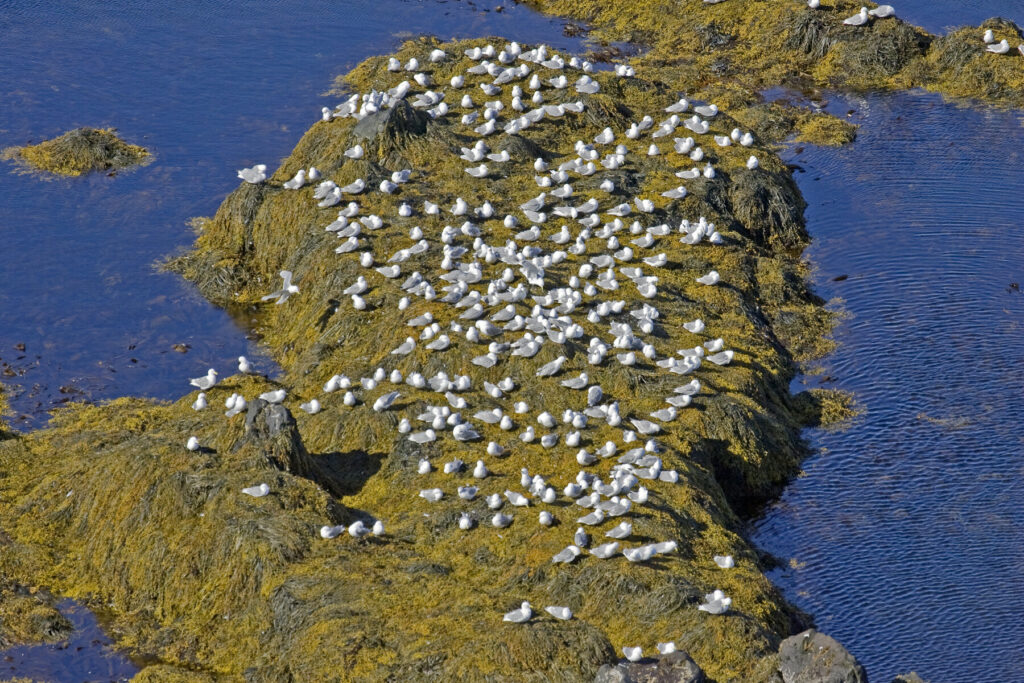
Látrabjarg
The great cliffs of Látrabjarg are one of the great natural wonders of Iceland. The vertical wall of layered basalt drops straight down into the waters of Breiðafjörður from such dizzying heights that the human eye fails to take it all in. It is impossible to exaggerate the sheer size of these cliffs: well over 400m (1,200ft ) high and more than 14km (8.6 miles) long.
The cliffs make everything else seem in miniature. Equally impressive is the massive bird population that make this their summer home. Látrabjarg is the largest bird cliff in Iceland and also in the entire northern hemisphere. Nobody’s had the patience to take an official count, but we know there are several million birds – enough to completely cover the cliff from one end to the other. It is a unique habitat and on such a massive scale that several seabird species sustain their population at this one spot.
From May to August, expect puffins, guillemots, razorbills, and fulmar in overwhelming numbers. The birds love the cliff for its perfect nesting spots and the abundant food below. The violent current that swirls off the tip of this peninsula is rich with fish – hence the birds, fishing boats, and a long history of shipwrecks. Birdwatchers will have a field day at this site.
Látrabjarg is also the westernmost point of Iceland (24° 32’W). On a clear, sunny day it is sometimes possible to see the glare from the ice cap in nearby Greenland, only 278km (173 miles) away. The cliff’s highest point is known as Heiðnakinn at 441m (1,447ft), or the ‘heathen wall’. The abrupt peak hints at the malevolent spirit said to reside here – a devil that cuts the ropes of the climbers gathering bird eggs. Such was the livelihood of locals who rappelled (abseiled) down the rock face, sending up flat baskets filled with guillemot eggs for food and sale. It is a sport of great agility and nerve, still practised in other parts of Iceland.
Crazily enough, Látrabjarg is not an officially protected nature reserve (yet), perhaps in part because so few travellers make it out this far. It takes some patience and effort to get here, but the experience is a powerful one.
Getting there and away
The only road to Látrabjarg (Route 612) is unpaved, bumpy, and quite steep in places. Be prepared, as the closest fuel stop is in Patreksfjörður (page 319), 60km away. In summer, Westfjords Adventures operate a bus that loops between Látrabjarg and Brjánslækur (3½ hrs) via Patreksfjörður on the way there and Rauðisandur (along Route 614) on the way back.
Mývatn
The volcanic wonderland of Mývatn is a bright oasis at the edge of Iceland’s desert highlands. Black lava fields give way to young mountains, interesting crater circles, and a flow of inland streams and lakes. The largest of these is Lake Mývatn, whose myriad pools and archipelagos are laid out with all the precision of a golf course. Yet only nature is to blame for the vivid colours and sublime contrast on offer: one hillside might be carpeted in grassy green, but the next is likely to be scorched white and dusted with yellow sulphur. It all depends on how the wind blows.
It is the famous Krafla hotspot that transforms a beautiful lake into an extraordinary landscape. The magma reservoir sits less than two miles beneath the surface – a literal bubble of volcanic activity that keeps things bubbling. Between the hot springs and mud pots the crusted ground is cracked and bulging. The most innocent outdoor stroll takes one past cones and calderas right out of a textbook. If anything, Mývatn inspires reflection about how the rest of the earth was made.
The lake of today was formed about 2,300 years ago in a routine eruption of one of the Krafla fissures. Often mistaken for a crater, Lake Mývatn is actually a very flat lava field that was dammed in around the edges by subsequent flows – that explains the vague shoreline, the size (more than 12km in length), the 40-odd islands in the middle and why the lake is so shallow (only 2–4m deep). The eruption disrupted the flow of the Laxá River and the new lake was filled with underground spring water. The two main basins of the lake were created separately and are fed by separate springs – in Syðriflói (the larger section) the water temperature averages 5°C; in Ytriflói (the northern end) the water gets up to 30°C.
The ‘Mývatn’ of travel brochures and road signs refers to the entire area: the lake, volcanoes, lava fields and steamy landscapes. As a destination, it’s right at the top of the list – stunning and easy to get to. Relatively speaking though, Mývatn remains gloriously undeveloped with just a handful of hotels and restaurants. Just over 500 people live here, on lakeside farms or in the village of Reykjahlið. When not catering to tourists, locals farm or work in one of two industries: the Krafla geothermal power plant and the local diatomite mine (taken from the lake’s fossilised algae deposits and used to make filters and abrasives).
Reykjanes Peninsula
Reykjanes may be one of the most interesting, yet overlooked, regions in Iceland. There’s a lot more to the place than the international airport and the Blue Lagoon. If you’re flying to Iceland, you’ll pass through the former and you’ll feel a lot better having passed through the latter, but that’s only just the beginning.
The southwest peninsula of Reykjanes, or ‘smoky point’, is an utterly strange region of surreal landscapes and desolate volcanic fallout. There are only crumbled lava rocks carpeted in thick, grey-green moss as far as the eye can see. There is no soil – only shifting, metallic black sand. The low mountains on the horizon are sleeping volcanoes, their forms the crusted spouts from whence flowed all this lava.
As an active geothermal hotspot, the broken ground exhales the wispy puffs of steam that gave the peninsula its name. The wind blows without cease and the frontal gusts of the Gulf Stream shoot out from across the ocean. The land is forever streaked with drizzle or sleet.
Whether you’re on a quick stopover, exploring Iceland in depth, or if you’ve got a spare day at the end of your trip, Reykjanes is a surface worth scratching beneath. Nowhere else captures the same curious beauty and bleak mood of this peninsula’s empty places, made even more mysterious by the constant flux of weather. There is great hiking to be done, a magnificent coastline to explore, and pure heat bubbling up from the depths. Reykjanes is also ideal for winter travel – it’s close to the airport, convenient, and compact. It’s also warmer than the rest of Iceland and there’s rarely any snow because it all gets blown away by the fierce wind. In fact, Reykjanes is the windiest region in the whole south of Iceland.
Reykjanesbær
Reykjanesbær is Iceland’s mini megalopolis that combines the towns of Keflavík, Hafnir and Njarðvík into one dynamic district of 16,000 people, many of whom are immigrants. That makes it the third-largest community in Iceland after the capital (not counting the suburbs) and Akureyri. At the heart of it all is Keflavík, a very functional town with row after row of perfect square blocks lined with two-storey concrete homes painted gaily in contrast to the lifeless lava mounds beyond. The harbour still serves as an active shipping and fishing port and continues to grow along the seashore.
Begin your explorations at the Duus Museum and Cultural Centre. It’s located above the peninsula’s visitor centre and inside you’ll find rotating displays at the Reykjanes Art Museum, information on the area’s history at the Reykjanes Museum of Heritage, and an exhibition on local handicrafts and design in the basement. There’s a lot going on here, so if it’s a rainy day you’re in luck.
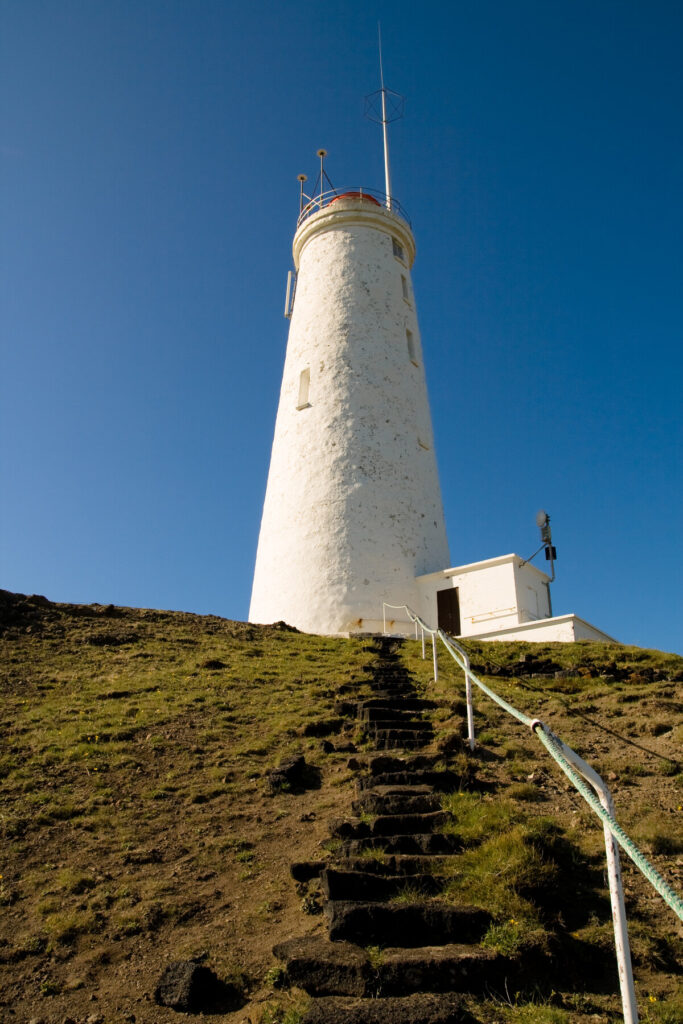
Gardur
The northwest tip of Reykjanes is pretty typical seashore with lots of screeching seagulls and fishing boats. The main highlight of Garður is the pair of lighthouses, the old traditional one (built 1847) and the new square one built in 1944.
Garðskagi is the northernmost point in Reykjanes, and given the right weather, you can capture Reykjavík in all its glory and see right across to the other side of Faxaflói. Heading down the coast brings you to the village of Sandgerði. If your idea of fun is barren isolation by the sea, there are cosy little summerhouses for rent.
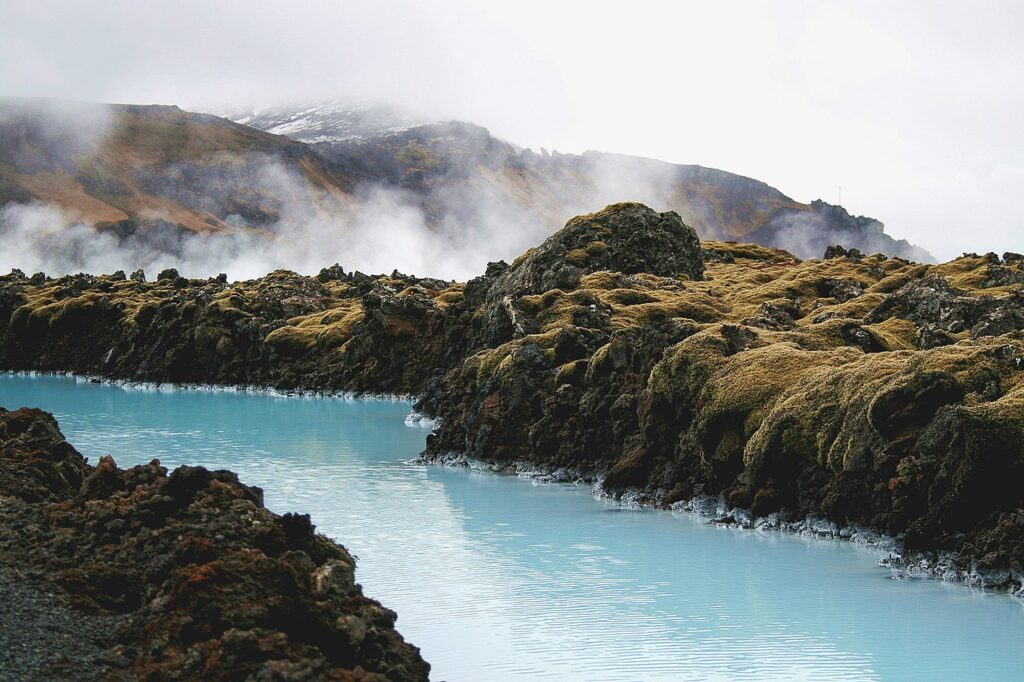
Blue Lagoon
Blue Lagoon is the most visited destination in Iceland, the proverbial ‘T-shirt’ proving you’ve been to the country. In the midst of the spooky black lavascape that is Reykjanes, the ethereal blue waters of this enormous manmade hot spring seem absolutely weird and strangely inviting. The minute you see a picture, you have to go, and once you’ve been, you have to go back. With every billboard, brochure, and tour guide pointing this way, it’s hard to avoid it.
Without a doubt, the Blue Lagoon is a gigantic tourist trap but my, what a lovely tourist trap to be trapped in. The lagoon is open year-round and the swimming is fine at any time. The lagoon is not deep (less than 5ft/150cm), but fluctuates based on the irregular shape. The bottom is covered with white silica mud, the result of a natural process of re-condensation. The silica does wonders for your skin, which is why everyone’s fighting over the little boxes and buckets to get a fistful of their own. Obviously, avoid your eyes when spreading it on your face. There’s also a dry sauna and two steam baths and a massage area, but none of that compares to a languorous soak.
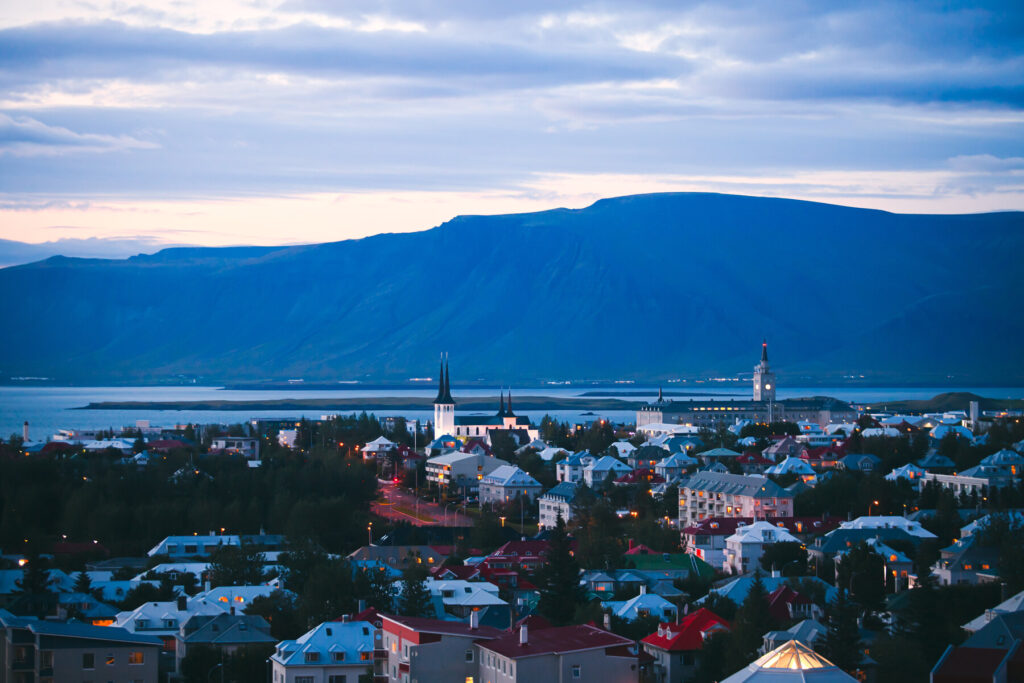
Reykjavík
A stunning backdrop pronounces Iceland’s picturesque capital: on one side of town stand rows of prim coloured rooftops outlined by a silvery, duck- and swan-filled lake. On the other, city streets slope down to the wind-capped bay of Faxaflói and a pair of quiet, bright-green islands. The mighty ridge of Mt Esja rises in the distance, perhaps the most treasured landmark in Reykjavík.
The city proper spreads out across Seltjarnanes, a peninsula whose optimal position affords (on a clear day) a tremendous panorama that extends from the tip of the Reykjanes Peninsula (near Keflavík Airport) all the way up to the icy dome of Snæfellsnes glacier, a good 100km away. This incredible view – and the remarkable sky that frames it – seems an open invitation to explore the great nature of Iceland.
What sets the capital apart from the rest of the country is the presence of people, cars, and trees – all rare species elsewhere in Iceland. Indeed, appreciating Iceland’s largest town raises the question, is Reykjavík a village that acts like a city or a city that feels like a village?
On the metropolitan side of things sit the Icelandic stock exchange, a massive harbour filled with sea-going ships, high-rise hotels, a stunning glass-panelled concert venue, the national parliament building, and an art, music, and restaurant scene that rivals anything in either London or Manhattan. Villagewise, the air is unbelievably clean, whales are jumping in the harbour, a church marks the highest point in the skyline, and by the second day you might start recognising the faces you pass in the street. It’s comforting to find such big-city delights in such a small and unusual package.
It’s nearly impossible to make any generalisations about the people of Reykjavík in terms of attitude, dialect, culture, or lifestyle. Instead, consider this town as the urban expression of Iceland as a whole, which is pretty diverse. One face of the city is dedicated solely to tourists, which is welcoming and sincere, if not a little overwhelming at times. Within that same grid lies the busy heart of Reykjavík where Iceland’s intellectual, financial, and cultural elite put in their serious hours.
Weekends witness the outrageous nightlife for which the city is famed, but by Sunday morning, the streets are as silent as the sleepy suburbs nearby. In fact, just 5 minutes from the city centre you’ll find wide pavements, clipped grass and open gardens, single-family houses with two-car garages, and giant shopping areas connected by four-lane highways (not the party town you might have expected).
City centre
A nice focal point is Austurvöllur (the ‘east field’), which plays the part of the city’s main square and most central park. Over a millennium ago, this was a cultivated field of Iceland’s very first settlement – sheep have continued to graze on the green ever since. Today, Austurvöllur reflects the utter tranquility and small size of Iceland’s capital city.
The field’s crisscrossed paths meet at the statue of Icelandic national hero Jón Sigurdsson, sculpted by Einar Jónsson in 1931 following the millennial celebrations of the Icelandic parliament. The statue proudly faces the front of the Alþingishúsið, or Parliament House, the modern seat of Iceland’s government. As impressive as it may appear, the two-storey stone building seems a faint counterpart to the law rock at Thingvellir and the Althing’s 1,000-year-old legacy.
The present building was designed by Danish architect Ferdinand Meldahl and constructed of grey-black dolerite, a hard local stone that gives a unique colour and texture to the outside. As one of the more stately and solid buildings in Reykjavík, Alþingishúsið has been used as temporary homes for the country’s national archives, the national library, and the University of Iceland (classes were taught on the main floor for nearly 30 years). Today, this is where Iceland’s 63 members of parliament meet to govern the country. The attached modern glass building was added in 1999 to provide additional office space.
Designed and planted in 1893, Althingisgarðurinn (Parliament House Garden) was the country’s first public garden and is probably the only place in the world where you can walk into parliament unannounced and not have a gun pointed at your face. Go to the back of the left side (when facing the front of the building) and enter at the swinging gate that opens on to the circular path. The tiny garden is planted with flowers, bushes and trees and forms one of the most peaceful spots in the city, not the kind of solitude you might expect behind the house of national government. A back gate leads out on to Vonarstræti.
Lækjartorg
Lækjartorg Square is the first open area outside the small cluster of the city centre, at the intersection of Lækjargata and Bankastræti. Today it’s a central vantage point for shopping, touring, dining, and clubbing and the city’s main transportation throughway. Stand near the square and you’ll spot whatever it is that you need (there’s a well-connected bus stop on the corner).
Sightseeing-wise, the white, slate-roofed Government House (Stjórnarráðshúsið) sits in the grassy centre of the actual square. The sturdy stone building was erected in 1770 as a prison but now serves as the offices for Iceland’s prime minister. Two statues grace the front lawn: on the right, the first native ‘prime minister’ of Iceland Hannes Hafstein, and on the left, King Christian IX of Denmark holding forth the Icelandic constitution which he brought to Iceland in 1874.
Tjörnin
The Tjörnin, or ‘pond’, separates the city centre from the east and west neighbourhoods and provides a scenic cross-section of the city, as portrayed in countless postcards and vacation photographs. It’s bigger than it looks, and a walk all the way around (take the bridge) is just under a mile in length (1.6 km). In winter, the pond freezes solid, and up until World War II, the Tjörnin was the main source of ice used for the city’s refrigeration purposes.
Geothermal runoff now empties in at the head of the pond, which prevents a small area from freezing and keeps all the waterbirds quite happy, of which there are many. Bird-wise, anything is possible, so don’t head off into the wild until you’ve had a look here. The range of species obviously shifts through the year, but you are always guaranteed to see some big swans and ducks (mainly scaup, eider and black ducks). In winter, you will see locals ice skating on the pond.
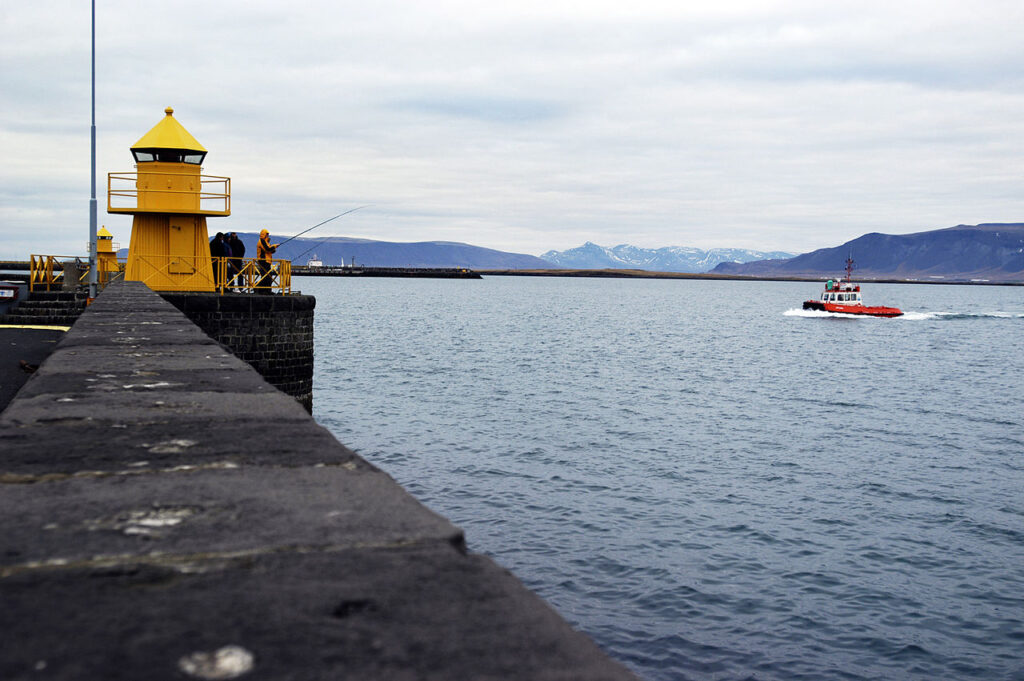
Harbour and waterfront
Reykjavík’s formerly forgotten waterfront is now one of the more exciting parts of the city. As a candid slice of urban history, the maze-like harbour is filled with all kinds of boats and grungy warehouses and fish smells that all confirm your travels. As a once-depressed industrial quarter, there’s plenty of artful graffiti and cool urban decay, though post-gentrification, it all fits with the trendy homes, lofts, restaurants, boutiques and guesthouses.
A brief walk down Geirsgata allows a fair taste of the neighbourhood, and a walk down the piers takes you past some of the newer developments. If you continue past the old harbour, you’ll quickly find yourself in the trendy Grandi neighbourhood. In recent years this area has been the focus of the city’s revitalisation efforts, and today you’ll find several good restaurants, cafés, and museums including Aurora Reykjavík and the Whales of Iceland exhibition.
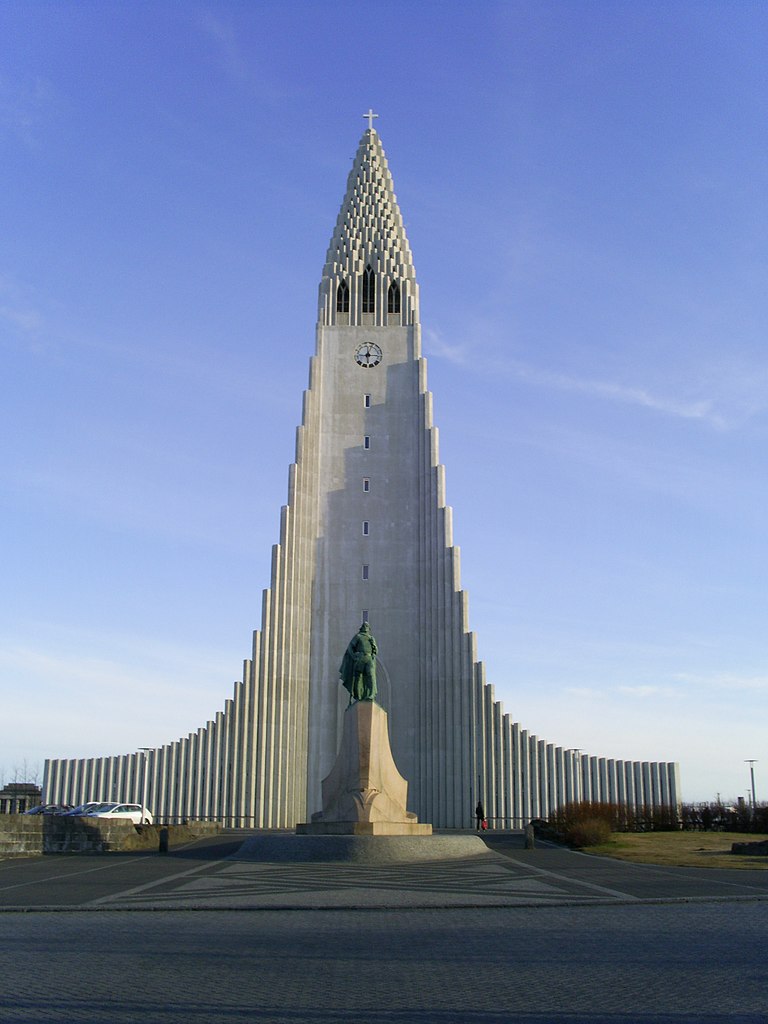
Hallgrímskirkja
The grey tower of Hallgrímskirkja defines the Reykjavík skyline in a most impressive way. At 245ft (74m) high, this is Iceland’s second tallest building and the city’s most prominent landmark – you can see the church from a good 25km away. Such totally unique architecture outweighs its very unique height. Indeed the church’s design has become a symbol of Reykjavík in its own right: an ancient theme that honours a past hero by invoking nature with modernism.
Laugavegur
Reykjavík offers lots of fabulous ways to spend money quickly. As a rule, never judge a shop by outward appearance alone. Sophisticated window displays may give way to super-tacky inventory, while grungy basement boutiques hold one-of-a-kind treasures.
The bulk of commerce lies within a concentrated area. Laugavegur is synonymous with shopping, and most tourists spend hours tramping up and down the hill, in and out of the few hundred shops that line either side of the city’s main drag. Laugavegur has it all, but the area favours upmarket clothing and fashion boutiques, many of which sell the work of local designers. Some of these shops make you feel cool just by stepping inside them. Be sure not to miss Hrím, a quirky store that is widely regarded as ground zero for Icelandic design.
Snæfellsnes and Snæfellsjökull National Park
Snæ-fells-nes merely means ‘snow mountain peninsula’, which it clearly is. Covered in a permanent shield of lumpy ice, Mt Snæfellsjökull (1,446m) is the tallest mountain in the long row of grey peaks that divides the sea between Breiðafjörður and Faxaflói.
Rising alone from the water, no other point is so visible from the rest of Iceland as this one majestic volcano.
You can find a striking Snaefellsnes peninsula itinerary here.
Be you in Reykjavík or in the West Fjords, a sunny day will grant you a vision of the mountain and its glacier. As you approach the peninsula the view becomes even more astounding, but once you arrive at the base, the mountain disappears – it is too big to see up close. The mystique of Snæfellsnes lies in its remarkable terrain, the energy of the mountains and the legends connected to this place.
Snæfellsnes seems a determined detour that might feel like going way out on a limb. Anxious tourists often bypass the whole area just to make good distance on the ring road. That is a big mistake, since they are missing a most magnificent place. This long volcanic ridge is a natural paradise with very few people and memorable landscapes. Serious hikers will want to trek any of the many trails, especially those that cross the peninsula – a short distance that ascends some mighty mountains.
Snæfellsjökull is the smallest of Iceland’s three national parks. It might also be the most fascinating, for the twisted lava shapes, its compact size, and the contrast from sea to icy summit. Geologists consider Mt Snæfellsjökull dormant but Icelanders insist the mountain is very much alive – the last eruption took place 1,800 years ago, but the previous 10,000-year period saw some 20 different eruptions. The volcano is one of the best-known Icelandic mountains outside Iceland, thanks to the adventure novelist Jules Verne, whose tale Journey to the Centre of the Earth takes its protagonists into the earth through the Snæfellsjökull volcano. Although he never travelled to Iceland, Verne aptly described the top of the mountain as a ‘vast dome of white’. In actuality, the summit is a deep 300m crater surrounded by three separate peaks. That means the glacier takes the shape of a lens filling the hollow of the volcano with a globe of ice.
As a national park, Snæfellsjökull offers a tranquil escape with powerful views. Below the white cap, the sloping lava descends into a rough and desolate landscape of grey-black hills, craters, cliffs, and fields of broken lava rock. This is not some kind of action-packed adventure land at the edge of a volcano. On the contrary, wandering through this lost world feels meditative and ethereal. If anything, Snæfellsjökull is pure silence. It’s gorgeous and serene, so if you have some spare time, be sure to spend it here.
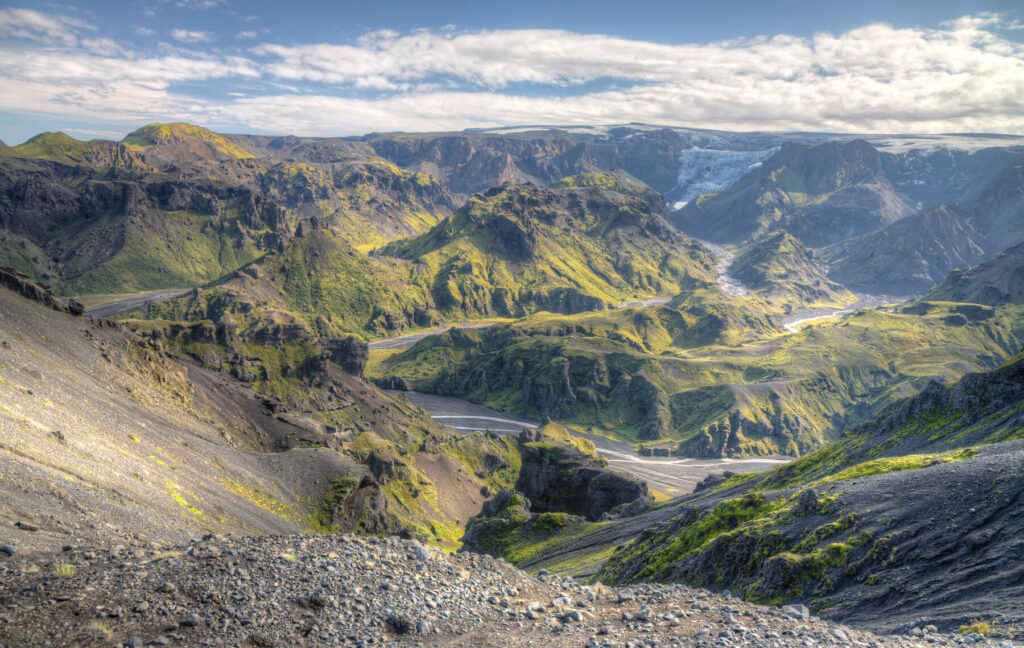
Thórsmörk and Landmannalaugar
Thórsmörk
‘Thór’s woods’ is renowned for its stunning nature, a transcendent, hidden valley beneath a romantic breadth of volcanic mountains. Hundreds of glacial streams pour down the mountainsides and combine into an immense swathe of braided, interlocking rivers that rush through the valley’s shifting bed of black sand. Thórsmörk also wows its visitors with all the great colours of Iceland: shiny, moss-green mountains, volcanic black pumice, the brown of aged basalt, steely-blue water, and snow-white glaciers whose long, icy tongues flow down into the valley. The tremendous scale of the place sets it apart from anything else and that is exactly why anyone with even a mild case of wanderlust should hurry there.
Alas, only a few can make it given that unless you’re hiking over the mountains, the only way in and out of the valley is along the banks of the very turbulent Krossá River. Driving to Thórsmörk becomes an amphibious activity, and those who actually get this far tend to bask in the light of their own bravado. And yet, to experience this corner of Iceland is something far bigger than machismo.
On the way into the valley, the road passes the pretty glacial tongues of Gígjökull and Steinsholtsjökull, both extending from Eyjafjallajökull. The woods, from whence comes the name ‘Thórsmörk’, include a number of shady, low-lying birch forests protected by the wind in the hollows between the mountains. Once you get into the heart of the valley, all you need are a good pair of hiking boots and the urge to explore hill and dale. A relatively short hike takes you to the top of Mt Valahnúkur (465m), offering great views out over the valley Langidalur. A longer trail goes to the top of Mt Rjúpnafell (830m) and another ascends to the icy edges of Mýrdalsjökull. Also, take a look at the tell-tale rock formations of Tröllakirkja (troll’s church). The trail to Skógar passes the southern uplands of the valley, known as Goðaland or ‘God’s land’. After a day’s hiking, have a good, hot soak in Thórslaug, the manmade but naturally heated wading pool near the Volcano Huts. Your body will thank you.
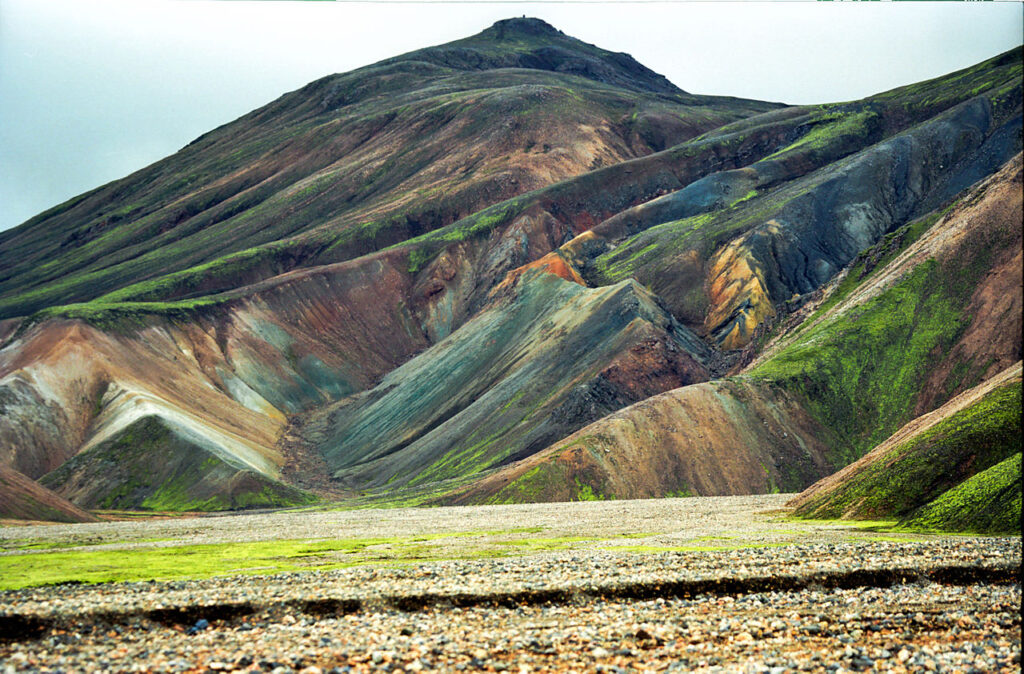
Landmannalaugar
Hot springs and volcanoes are found just about everywhere in Iceland, but nothing compares to the wild wonderland that is Landmannalaugar (pronounced lahndmahn-a-loy-gahr). Halfway between the volcanoes of Laki and Mt Hekla, this polygon-shaped nature reserve encloses a mysterious landscape made from the many forms of water and lava.
Pictured in almost every travel brochure out there, the mountains of Landmannalaugar are pure rhyolite – a crystallised, slow-forming igneous rock that is far more interesting than the basic basalt blocks seen everywhere else in Iceland. The colourful stone forms smooth, pyramidshaped peaks, with slopes that lie somewhere between gentle and unforgiving. Depending on the weather and the light, the rocks and sand shine yellow and reddish-brown, streaked with blue, green, and purple ash impacted from ancient eruptions.
On other days, the earth seems scorched and lifeless. In fact, much of Landmannalaugar is dead, the desert wake of volcanic destruction. The steam rising up from each valley adds a mystical sense and leads to the hidden lives of all the rivers, pools and springs that mark the land. Each is a private oasis where green marshes flourish in spite of the cold.
The name Landmannalaugar simply means ‘bath of the land’s men’, which points to a long history of travellers who liked to come here for a warm dip in the many springs. Some things never change, and this is still the number-one spot in Iceland for all-natural, outdoor bathing.
Until recently, unpredictable rivers and the tricky lava fields around Mt Hekla prevented mass tourist development, but as the ultimate highland destination, Landmannalaugar now attracts more hikers than the trail can handle in a single season. Like all beautiful, remote places that become extremely popular too quickly, the scene at the main camp flips from a chaos of caravans one minute to ghostly emptiness the next.
From mid-July to mid-August, the place is a jam-packed hiking hell, not bad if you don’t mind having your wilderness with a side of civilisation. However, do not despair, as it’s quite easy to step off the beaten path (just don’t step too far away). Take particular note of all signs and warnings. Just climb to the top of a hill and in every direction, the mountains go on forever.
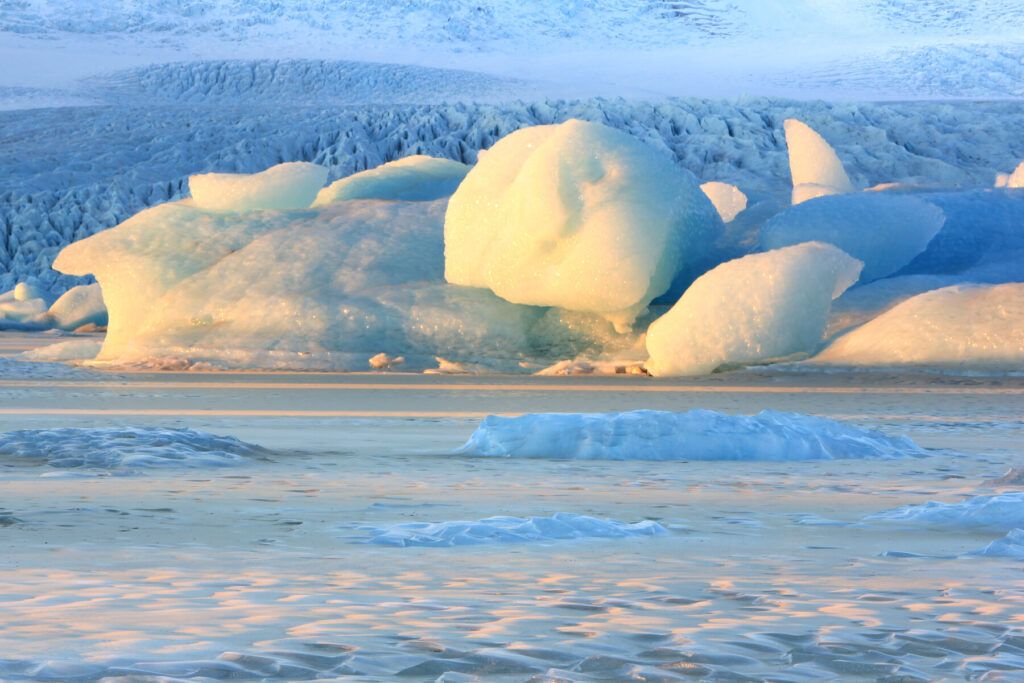
Vatnajökull
Iceland’s Vatnajökull is the largest glacier in Europe and the third largest in the world (after the ice caps in Antarctica and Greenland). The glacier’s entire surface area is 8,300km² (3,400 square miles), which covers roughly 8% of the country (about the size of Puerto Rico). The ice averages 500m thickness, but is more than 1,000m deep in some places. The glacier is so massive that each of the many tongues have their own names and are referred to as separate glaciers. Unlike other glaciers that are formed by accumulated and firmly packed snow, Vatnajökull is a remaining piece of the last ice age – part of the polar ice cap that formed Iceland’s coasts and terrain.
Vatnajökull embodies all the extremes of Iceland – the highest elevation, the coldest temperatures, the biggest volcanic eruptions, the highest precipitation, and fastest winds. It is one of the most exotic things foreigners can experience in Iceland – there’s something about driving along a ribbon of highway with giant licks of ice spilling down towards you. Up close, Vatnajökull can show itself as a snowy field of white, or expose all the gorgeous colours and strange shapes of compressed ice. Also, the view from the top – over the ocean or the mountainous interior – is superb.
Nobody can say who the first people to cross the glacier were, since the early Icelanders were known to have scoured every last bit of their country. The first recorded north–south crossing was in 1875 by Icelandic guide Páll Pálsson and the Scottish explorer W L Watts. This was followed by the 1932 ‘Cambridge Expedition’ in which a few English students made a traverse journey across and back in just five days. Since then, the glacier has attracted the attention of several masochists: in 2004, explorer Cameron Smith completed the first solo east–west crossing in winter.
Of all the glaciers in Iceland, Vatnajökull is receding the fastest – every summer, locals can point to where the ice reached in the previous year. Pushing aside the uneasy jokes about global warming, there is a real urgency to visit – evident in the recent jump in European tourists who come specifically to see the ice. Feel free to explore, but put safety first. Pay particular attention to the weather conditions and bring the proper gear with you.
Related books
For more information, see our guide to Iceland:
Articles about Iceland
Celebrate the final season of Game of Thrones hitting our screens by taking a look at some of the locations that have starred in the show.
